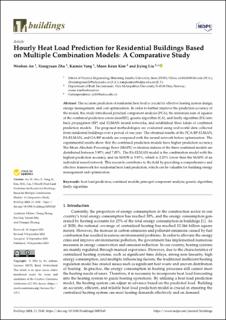Hourly Heat Load Prediction for Residential Buildings Based on Multiple Combination Models: A Comparative Study
| dc.contributor.author | An, Wenhan | |
| dc.contributor.author | Zhu, Xiangyuan | |
| dc.contributor.author | Yang, Kaimin | |
| dc.contributor.author | Kim, Moon Keun | |
| dc.contributor.author | Liu, Jiying | |
| dc.date.accessioned | 2023-11-20T07:00:11Z | |
| dc.date.available | 2023-11-20T07:00:11Z | |
| dc.date.created | 2023-10-23T10:59:20Z | |
| dc.date.issued | 2023 | |
| dc.identifier.citation | Buildings. 2023, 13 (9), . | en_US |
| dc.identifier.issn | 2075-5309 | |
| dc.identifier.uri | https://hdl.handle.net/11250/3103420 | |
| dc.description.abstract | The accurate prediction of residential heat load is crucial for effective heating system design, energy management, and cost optimization. In order to further improve the prediction accuracy of the model, this study introduced principal component analysis (PCA), the minimum sum of squares of the combined prediction errors (minSSE), genetic algorithm (GA), and firefly algorithm (FA) into back propagation (BP) and ELMAN neural networks, and established three kinds of combined prediction models. The proposed methodologies are evaluated using real-world data collected from residential buildings over a period of one year. The obtained results of the PCA-BP-ELMAN, FA-ELMAN, and GA-BP models are compared with the neural network before optimization. The experimental results show that the combined prediction models have higher prediction accuracy. The Mean Absolute Percentage Error (MAPE) evaluation indices of the three combined models are distributed between 5.95% and 7.05%. The FA-ELMAN model is the combination model with the highest prediction accuracy, and its MAPE is 5.95%, which is 2.25% lower than the MAPE of an individual neural network. This research contributes to the field by providing a comprehensive and effective framework for residential heat load prediction, which can be valuable for building energy management and optimization. | en_US |
| dc.language.iso | eng | en_US |
| dc.rights | Navngivelse 4.0 Internasjonal | * |
| dc.rights.uri | http://creativecommons.org/licenses/by/4.0/deed.no | * |
| dc.title | Hourly Heat Load Prediction for Residential Buildings Based on Multiple Combination Models: A Comparative Study | en_US |
| dc.type | Peer reviewed | en_US |
| dc.type | Journal article | en_US |
| dc.description.version | publishedVersion | en_US |
| cristin.ispublished | true | |
| cristin.fulltext | postprint | |
| cristin.fulltext | original | |
| cristin.qualitycode | 1 | |
| dc.identifier.doi | 10.3390/buildings13092340 | |
| dc.identifier.cristin | 2187535 | |
| dc.source.journal | Buildings | en_US |
| dc.source.volume | 13 | en_US |
| dc.source.issue | 9 | en_US |
| dc.source.pagenumber | 20 | en_US |
Files in this item
This item appears in the following Collection(s)
-
Publikasjoner fra Cristin [3269]
-
TKD - Institutt for bygg- og energiteknikk [416]
TKD - Department of Built Environment

